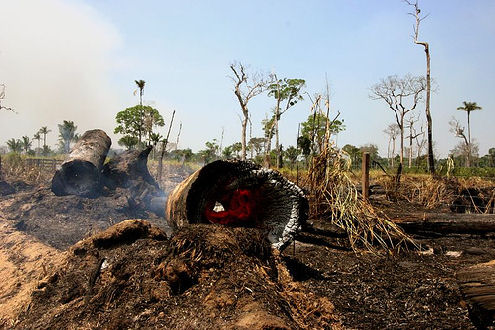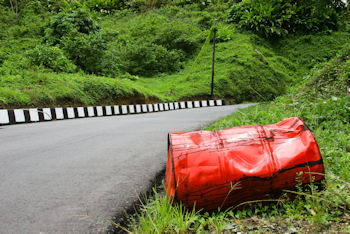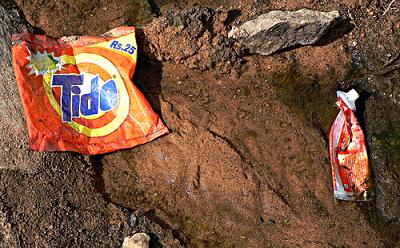Pollution Effects
We discuss pollution effects on humans, animals, plants and the Environment. ~ By Irina Bright
This article is part of our Environment section
See the complete list of all our Pollution Articles here.
Pollution effects are indeed many and wide-ranging. There is no doubt that excessive levels of pollution are causing a lot of damage to human & animal health, tropical rainforests, as well as the wider environment.
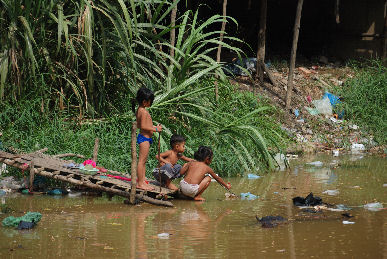 Playing With Pollution
Playing With Pollution© Olivier Meerson
All types of pollution – air, water and soil pollution – have an impact on the living environment.
The effects in living organisms may range from mild discomfort to serious diseases such as cancer to physical deformities; ex., extra or missing limbs in frogs.
Experts admit that pollution effects are quite often underestimated and that more research is needed to understand the connections between pollution and its effects on all life forms.
Pollution Effects on Humans
We know that pollution causes not only physical disabilities but also psychological and behavioral disorders in people.
We are discussing the effects of air pollution and specific air pollutants in more detail in our Air Pollution Effects article.
The following pollution effects on humans have been reported:
Air Pollution Effects (Ref. 1, 2)
 Air Pollution in Philippines
Air Pollution in PhilippinesPhoto: Jim D Stitch
- Reduced lung functioning
- Irritation of eyes, nose, mouth and throat
- Asthma attacks
- Respiratory symptoms such as coughing and wheezing
- Increased respiratory disease such as bronchitis
- Reduced energy levels
- Headaches and dizziness
- Disruption of endocrine, reproductive and immune systems
- Neurobehavioral disorders
- Cardiovascular problems
- Cancer
- Premature death
Water Pollution Effects (Ref. 3)
 Water Pollution, California
Water Pollution, California Photo: Caleb Coppola
Waterborne diseases caused by polluted drinking water:
- Typhoid
- Amoebiasis
- Giardiasis
- Ascariasis
- Hookworm
Waterborne diseases caused by polluted beach water:
- Rashes, ear ache, pink eye
- Respiratory infections
- Hepatitis, encephalitis, gastroenteritis, diarrhoea, vomiting, and stomach aches/li>
Conditions related to water polluted by chemicals (such as pesticides, hydrocarbons, persistent organic pollutants, heavy metals etc):
- Cancer, incl. prostate cancer and non-Hodgkin’s lymphoma
- Hormonal problems that can disrupt reproductive and developmental processes
- Damage to the nervous system
- Liver and kidney damage
- Damage to the DNA
- Exposure to mercury (heavy metal):
- In the womb: may cause neurological problems including slower reflexes, learning deficits, delayed or incomplete mental development, autism and brain damage
- In adults: Parkinson’s disease, multiple sclerosis, Alzheimer’s disease, heart disease, and even death
Other notes:
- Water pollution may also result from interactions between water and contaminated soil, as well as from deposition of air contaminants (such as acid rain)
- Damage to people may be caused by fish foods coming from polluted water (a well known example is high mercury levels in fish)
- Damage to people may be caused by vegetable crops grown / washed with polluted water (author’s own conclusion)
Soil Pollution Effects (Ref. 4)
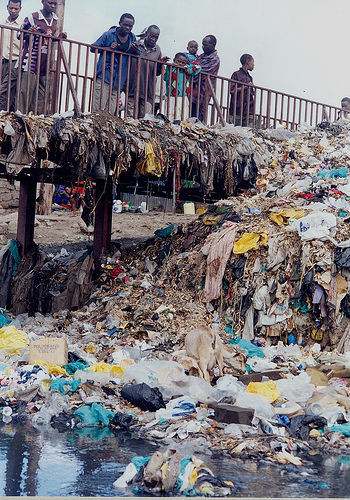 Soil and Water Pollution, Kenya
Soil and Water Pollution, KenyaPhoto: Tom Maruko
- Causes cancers including leukaemia
- Lead in soil is especially hazardous for young children causing developmental damage to the brain
- Mercury can increase the risk of kidney damage; cyclodienes can lead to liver toxicity
- Causes neuromuscular blockage as well as depression of the central nervous system
- Also causes headaches, nausea, fatigue, eye irritation and skin rash
Other notes:
- Contact with contaminated soil may be direct (from using parks, schools etc) or indirect (by inhaling soil contaminants which have vaporized)
- Soil pollution may also result from secondary contamination of water supplies and from deposition of air contaminants (for example, via acid rain)
- Contamination of crops grown in polluted soil brings up problems with food security
- Since it is closely linked to water pollution, many effects of soil contamination appear to be similar to the ones caused by water contamination
An Extreme Oil Pollution Case
Pollution of pristine Ecuador rainforest by Texaco / Chevron oil corporation represents perhaps one of the most outrageous cases of oil pollution ever.
Some levels of pollutants left by the company on its sites of oil exploration have been calculated to exceed the US safety standards by as much as 1,000 times, causing such side effects as children born with fused fingers and deformed eyes, high cancer rates, etc.
For more details, check out the Oil Pollution of Ecuador Rainforest article.
Pollution Effects on Animals
Effects of Pollution on Animals - Air Pollution (Ref. 5)
- Acid rain (formed in the air) destroys fish life in lakes and streams
- Excessive ultraviolet radiation coming from the sun through the ozone layer in the upper atmosphere which is eroded by some air pollutants, may cause skin cancer in wildlife
- Ozone in the lower atmosphere may damage lung tissues of animals
Effects of Pollution on Animals - Water Pollution (Ref. 6)
 Oil Coated Duck
Oil Coated DuckPhoto: Jack Wolf
- Nutrient pollution (nitrogen, phosphates etc) causes overgrowth of toxic algae eaten by other aquatic animals, and may cause death; nutrient pollution can also cause outbreaks of fish diseases
- Chemical contamination can cause declines in frog biodiversity and tadpole mass
- Oil pollution (as part of chemical contamination) can negatively affect development of marine organisms, increase susceptibility to disease and affect reproductive processes; can also cause gastrointestinal irritation, liver and kidney damage, and damage to the nervous system
- Mercury in water can cause abnormal behavior, slower growth and development, reduced reproduction, and death
- Persistent organic pollutants (POPs) may cause declines, deformities and death of fish life
- Too much sodium chloride (ordinary salt) in water may kill animals (Ref. 7)
Other notes:
- We also assume that some higher forms of non-aquatic animals may have similar effects from water pollution as those experienced by humans, as described above
Effects of Pollution on Animals - Soil Pollution (Ref. 8)
- Can alter metabolism of microorganisms and arthropods in a given soil environment; this may destroy some layers of the primary food chain, and thus have a negative effect on predator animal species
- Small life forms may consume harmful chemicals which may then be passed up the food chain to larger animals; this may lead to increased mortality rates and even animal extinction
Pollution Effects on Trees and Plants
Air Pollution (Ref. 9)
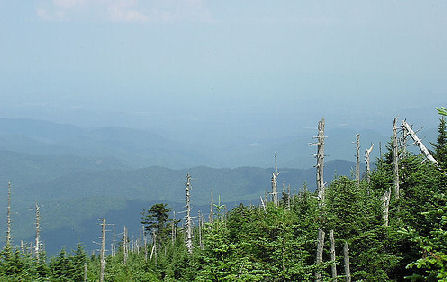 Trees Damaged by Acid Rain
Trees Damaged by Acid RainPhoto: Lindley Ashline
- Acid rain can kill trees, destroy the leaves of plants, can infiltrate soil by making it unsuitable for purposes of nutrition and habitation
- Ozone holes in the upper atmosphere can allow excessive ultraviolet radiation from the sun to enter the Earth causing damage to trees and plants
- Ozone in the lower atmosphere can prevent plant respiration by blocking stomata (openings in leaves) and negatively affecting plants’ photosynthesis rates which will stunt plant growth; ozone can also decay plant cells directly by entering stomata
Water Pollution
- May disrupt photosynthesis in aquatic plants and thus affecting ecosystems that depend on these plants (Ref. 10)
- Terrestrial and aquatic plants may absorb pollutants from water (as their main nutrient source) and pass them up the food chain to consumer animals and humans
- Plants may be killed by too much sodium chloride (ordinary slat) in water (Ref. 11)
- Plants may be killed by mud from construction sites as well as bits of wood and leaves, clay and other similar materials (Ref. 12)
- Plants may be killed by herbicides in water; herbicides are chemicals which are most harmful to plants (Ref. 13)
Soil Pollution
- May alter plant metabolism and reduce crop yields (Ref. 14)
- Trees and plants may absorb soil contaminants and pass them up the food chain
Pollution Effects on Wider Environment
Apart from destroying the aquatic life in lakes and streams, acid rain can also corrode metals, damage surfaces of buildings and monuments, and cause soil acidification.
Pollution of water may cause oxygen depletion in marine environments and severely affect the health of whole ecosystems. (Ref. 15)
How Does The Environment React To Different Pollution Levels?
Miguel A. Santos notes that a very important aspect of the effect of pollution is its dose (or concentration) required to cause environmental damage. (Ref. 16)
He defines pollution response as “the change in the effect of a pollutant in response to a change in its concentration”. (Ref. 17)
In this respect, he identifies 3 different types of response evoked by the environment to different pollution concentrations: (Ref. 18)
- Linear effect
- Greater-than-linear effect
- Threshold effect
In the linear effect, environmental damage increases linearly with pollution concentrations. In other words, “ the total damage or risk is directly proportional to the accumulated exposure”. (Ref. 19)
This effect occurs with radioactive substances as well as mercury, lead, cadmium and asbestos.
In the greater-than-linear effect, environmental damage increases with an increase in pollution concentrations but at a decreasing rate. This means that, as pollution concentrations continue to increase the environmental damage will continue to decrease. (Ref. 20)
This is the case with thermal pollution.
In the threshold effect, pollution produces no effect until a certain threshold in pollution concentrations is achieved. In other words, “so long as a given threshold is not exceeded, the damage from pollution would be completely repaired as quickly as it is produced”. (Ref. 21)
This effect is found with biodegradable pollutants.
It is also important to mention synergistic effects of pollutants on the environment. While interacting with each other, pollutants can produce greater impacts than when acting individually. (Ref. 22)
A good example of that is a synergy between asbestos exposure and smoking in causing lung cancer. (Ref. 23)
More Pictures of Pollution Effects
Written by: Irina Bright
Original publication date: 2008
Updates: 2012
Republication date: 2020
References
1. Colls, J. (2002). Air Pollution. New York: Spon Press, p. 388. Retrieved April 3, 2008 from Questia.com
2. Summary of Air Pollutants Table
3. Adapted from:
Water Pollution Effects (December, 2006). In Grinning Planet, Saving the Planet One Joke At A Time. Retrieved March 25, 2008 from http://www.grinningplanet.com/2006/12-05/water-pollution-effects.htm
4. Soil contamination. (March 16, 2008). In Wikipedia, The Free Encyclopedia. Retrieved April 3, 2008 from http://en.wikipedia.org/w/index.php?title=Soil_contamination&oldid=198686131
5. Gardiner, L. (February, 2006). Air Pollution Affects Plants, Animals, and Environments. Windows to the Universe. Retrieved April 3, 2008 from http://www.windows.ucar.edu/tour/link=/earth/Atmosphere/wildlife_forests.html&edu=high
6. Adapted from:
Water Pollution Effects (December, 2006). In Grinning Planet, Saving the Planet One Joke At A Time. Retrieved March 25, 2008 from http://www.grinningplanet.com/2006/12-05/water-pollution-effects.htm
7. Kopaska-Merkel, D. (November, 2000). How Does Water Pollution Affect Plant Growth? Mad Sci Network. Retrieved April 3, 2008 from http://www.madsci.org/posts/archives/2000-11/974847556.En.r.html
8. Soil contamination. (March 16, 2008). In Wikipedia, The Free Encyclopedia. Retrieved April 3, 2008 from http://en.wikipedia.org/w/index.php?title=Soil_contamination&oldid=198686131
9. Gardiner, L. (February, 2006). Air Pollution Affects Plants, Animals, and Environments. Windows to the Universe. Retrieved April 3, 2008 from http://www.windows.ucar.edu/tour/link=/earth/Atmosphere/wildlife_forests.html&edu=high
10. Water pollution. (March 25, 2008). In Wikipedia, The Free Encyclopedia. Retrieved April 3, 2008 from http://en.wikipedia.org/w/index.php?title=Water_pollution&oldid=200692274
11. Kopaska-Merkel, D. (November, 2000). How Does Water Pollution Affect Plant Growth? Mad Sci Network. Retrieved April 3, 2008 from http://www.madsci.org/posts/archives/2000-11/974847556.En.r.html
12. Ibid.
13. Ibid.
14. Soil contamination. (March 16, 2008). In Wikipedia, The Free Encyclopedia. Retrieved April 3, 2008 from http://en.wikipedia.org/w/index.php?title=Soil_contamination&oldid=198686131
15. Water pollution. (March 25, 2008). In Wikipedia, The Free Encyclopedia. Retrieved April 3, 2008 from http://en.wikipedia.org/w/index.php?title=Water_pollution&oldid=200692274
16. Santos, M. A. (1990). Managing Planet Earth: Perspectives on Population, Ecology, and the Law. Westport, CT: Bergin & Garvey, p. 63. Retrieved April 3, 2008 from Questia.com
17. Ibid.
18. Ibid, pp. 63 – 64
19. Ibid, p. 63
20. Ibid, pp. 63 – 64
21. Ibid, p. 64
22. Ibid.
23. Ibid
